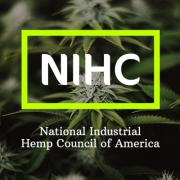
By Beau R. Whitney, NIHC Chief Economist
 The growth and expansion of the hemp industry has received some tough setbacks over the past three years. From regulatory uncertainty and an immature infrastructure to the lack of standards and oversupply of CBD biomass, the industry has not seemed to catch a break. This is typical for a nascent industry and there is always a learning curve.
The growth and expansion of the hemp industry has received some tough setbacks over the past three years. From regulatory uncertainty and an immature infrastructure to the lack of standards and oversupply of CBD biomass, the industry has not seemed to catch a break. This is typical for a nascent industry and there is always a learning curve.
One thing that has seemingly been overlooked by many about the hemp industry is that it is an agricultural-based industry and is subject to the whims of mother nature. Even though there are regulatory and business dynamics, it is still a crop that is influenced not only by other ag industries, but also the sun and the rain.
The influence of pandemic, economic and environmental factors.
The pace of growth has been influenced by many factors outside of the business and regulatory environments and these factors have showed signs of slowing the growth of the industry. The true extent of this will not be quantified until this fall once more of our research on licenses, supply and operator sentiment has been completed.
The COVID-19 impact on commodity prices.
The COVID-19 period created some head winds when it came to the perception about hemp investment. While higher THC cannabis was given essential business designations, hemp was not so lucky. Without essential status, hemp operators struggled to get the word out. Investment into the hemp industry slowed, as did access to retail channels. Hemp product manufacturers had to pivot and find new channels for distribution. This had a ripple effect throughout the value chain from processors to cultivators.
As the hemp industry struggled, other commodities flourished. A surge in demand for other commodities based on pandemic-related panic buying coincided with historic low prices for hemp. Commodity prices for corn, soy, wheat all surged due to the increase in demand. This is reflected in the price of cereals, tortillas, flour and other consumer staples to such an extent that it has sparked fears of sustained inflation in the broader economy.

Economics: With rising prices, traditional farmers stayed the course.
With rising prices for other commodities, those farmers who were considering transitioning some acreage over to hemp are no longer, at least not in the short run. As prices rise in traditional agricultural commodities, farmers that would have engaged in hemp are now disincentivize to do so.
Recently, when discussing their strategy regarding hemp, a farmer summed it up rather succinctly, “Farmers rarely plant crops without having a buyer or contract in place. With the demand dynamics favoring corn and soy, we are staying the course.”
Farmers rarely plant their crop without a buyer… unless you are in hemp.
While having a contract in place is common throughout the agricultural industry, for some reason hemp is different. In consecutive surveys from 2019 and 2020, 65% of hemp cultivators did not have a buyer for their crop. This has led to oversupply, falling prices and uncertainty in the hemp industry. The slowdown in the transition to hemp has as much to do with a profit margins as it has to do with a lack of buyers.
At some point, those who remain steadfast in the hemp market will be rewarded. The potential of hemp is too great to ignore. … There will be a point where the entrepreneurial spirit will prove to be irresistible.
Environmental: Wildfires, floods and extreme heat have also contributed.
Also contributing to the rise in prices for commodities has been the extreme weather events. Wildfires, floods and extreme heat have impacted traditional crops, tightened supplies and driven up prices right when hemp farmers would be planting. With the certainty associated with traditional commodities, and the uncertainty associated with hemp, expansion of the hemp industry has slowed. This pricing dynamic is something hemp farmers must factor into their strategy for the foreseeable future.
The unintended consequences on fiber and grain.
While CBD oversupply and price declines tend to dominate the headlines and instilling uncertainty in the hemp opportunity, fiber and grain have also been caught up in the fray. Entering into the 2021 season, there was an estimated 201 million pounds of excess CBD biomass supply in the market. This excess has created an additional disincentive to cultivate hemp, even fiber or grain. With the potential of fiber and grain in such massive markets such as automotive, construction, animal feed and plastics, it is unfortunate that surging prices for other commodities are overshadowing the true potential of hemp, right at a time when investment is needed most.
Challenges create opportunity.
At some point, those who remain steadfast in the hemp market will be rewarded. The potential of hemp is too great to ignore. With significant consumer demand and a strong drive towards at a sustainable economy, there will be a point where the entrepreneurial spirit will prove to be irresistible. So even though there have been some major headwinds slowing the growth of the market, there is positive momentum nonetheless. Calmer waters are ahead and for those that are able to overcome these present challenges, those hemp operators will be leagues ahead of the competition.















